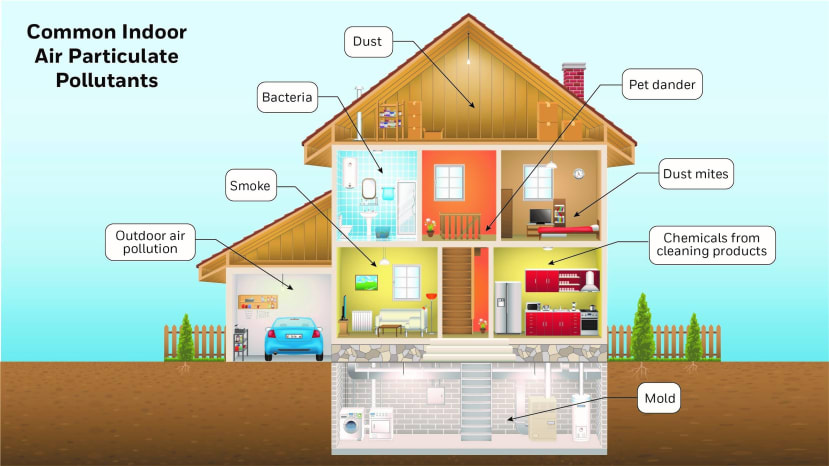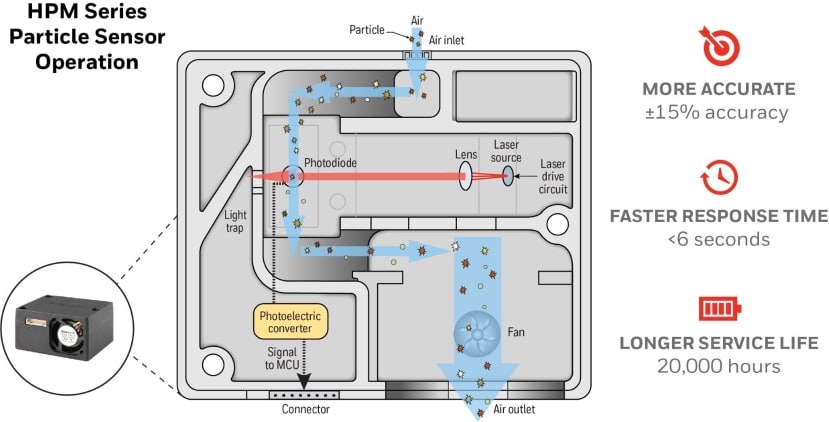Honeywell HPM Series Particle Sensor: Measure and Manage Air Quality
Follow articleHow do you feel about this article? Help us to provide better content for you.
Thank you! Your feedback has been received.
There was a problem submitting your feedback, please try again later.
What do you think of this article?
A recently updated article by the European Environment Agency (EEA) presented a thought-provoking concept: the air on a busy street, with average traffic, may be cleaner than the air in an individual’s living room. The EEA states, “Recent studies indicate that some harmful air pollutants can exist in higher concentrations in indoor spaces than outdoors. In the past, indoor air pollution received significantly less attention than outdoor air pollution, especially outdoor air pollution from industrial and transport emissions. However, in recent years the threats posed by exposure to indoor air pollution have become more apparent.” (EEA Report No 13/2017; ISSN 1977-8449)
Reduced indoor air quality can be dangerous to young children, seniors, and individuals with compromised immune systems and/or respiratory problems. In fact, air that has a high particulate count can trigger asthma attacks, as well as lead to irritated eyes, nose and throat irritation, coughing, heart disease, and other health-related issues. The direct link between air quality and personal health was documented in the EEA study, “Estimates of the health impacts attributable to exposure to air pollution indicate that PM2.5 concentrations in 2014 were responsible for about 428,000 premature deaths (2013-2015 data).”
PM2.5 refers to atmospheric particulate matter (PM) with a diameter of less than 2.5 µm (micrometers), which is about 3% of the diameter of a human hair. Particles in this category are so small they are only detected with an electron microscope. They are even smaller than their larger counterparts PM10 (10 µm or less). For example, particulates 10 µm in diameter include dust, pollen grains, and mould spores; all which may lodge into the lungs. Particles less than 2.5 µm in diameter include smoke, smog, bacteria, fine dust, and liquid droplets. These particles may lodge deeper into the lungs, causing longer-term illness. (See Figure 1).
Figure 1. PM2.5 and PM10 diameters compared to a strand of human hair
The EEA cites main indoor air pollutants as radon (a radioactive gas formed in the soil), tobacco smoke, and gases and/or particles from burning fuels, chemicals, and allergens. Carbon monoxide, nitrogen dioxide, particles, and volatile organic compounds can be found both outdoors and indoors. (See Figure 2, Common Indoor Air Particulates, below)
Particulate sensing and control is steadily increasing worldwide due to regulatory and government requirements, especially in regards to pollution as it relates to health and wellness. Particle sensors play a critical role in measuring and managing air quality to help maintain an individual’s health.
The Honeywell HPM Series Particle Sensor is a laser-based device which uses a light scattering method to provide more reliable and precise detection of airborne particulates in the PM2.5 and PM10 range over a concentration span of 0 µg/m3 to 1,000 µg/m3 in a given environment. The HPM Series features a compact design allowing it to be integrated into a variety of applications such as traditional HVAC controls, indoor air monitors, air purification equipment, automotive cabin filtration, and commercial kitchen ventilation. (Watch the video below to find out more).
The sensor outputs an electrical signal that can be fed into HVAC control systems in buildings and homes or into other air monitoring devices. This information can alert building operators that air purification systems should be activated, if outdoor air could be used to improve indoor air quality, when an air filter needs to be changed, or when early maintenance should be performed on indoor air delivery systems.
The HPM Series uses a laser-based sensing design which increases accuracy; it is able to detect particulate densities to within ±15 % accuracy. Some competitive devices offer accuracy of ±30 % or worse. With an expected service life of 20,000 hours, the HPM will operate for seven years when used for eight hours a day. It also has a faster response time, as the HPM Series analyzes media in less than six seconds. This speed allows the Honeywell particle sensor to analyze and provide data to supporting equipment, allowing the device to respond to changing conditions in real-time. (See Figure 4 below).
Figure 4. Honeywell HPM Series Particle Sensor Operation
The HPM Series operates in four key steps:
- The fan at the air outlet draws the air in through the air inlet.
- The air sample passes through the laser beam where the light reflected off the particles is captured and analyzed.
- The photoelectric converter processes the signal into particle size and density.
- The signal is transmitted to the micro control unit (MCU) where a proprietary algorithm processes the data and supplies outputs for the density of the particulate (µg/m3).
After receiving the sensor’s output, the equipment responds as programmed.
The HPM Series’ proven EMC performance and enhanced reliability mean the sensors can perform more accurately in a variety of tough environmental conditions. To learn more about the HPM Series visit this link, or alternatively see the range at RS, Particle Counter (145-4277) and Air Quality Sensor (145-4279) .




